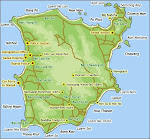 Do not confuse sak yant with the increasingly popular holiday compulsion among young people that, until quite recently, was the menacing fashion of heavy-metal rockers, bikers, criminals, love-lorn sailors, football hooligans and the social outcast. They share only skin and ink. Let's draw a line under it.
Do not confuse sak yant with the increasingly popular holiday compulsion among young people that, until quite recently, was the menacing fashion of heavy-metal rockers, bikers, criminals, love-lorn sailors, football hooligans and the social outcast. They share only skin and ink. Let's draw a line under it.______________________________
The belief system also maintains that material objects possess a soul and some have an influential engagement with one's own karma or fate. The best example of this in Western or Christian society would be the wearing of a lucky charm, a St Christopher or holy medal. In Thailand, amulets are worn as bracelets or on a chain about the neck to act as a talisman. Sacred tattoos, or sak yant, like amulets which have been blessed, are believed to carry powers of their own.
In Thai tradition, being tattooed by a monk is a deeply spiritual experience and was very common among men who believed that their tattoo would grant them strength and protection, not only from the spirit world, but from danger and in particular, harm from weapons. Sak Yant remains popular with soldiers, policemen and gangsters.
Only sacred monks can apply this work and today it is practiced in only a very few temples. The most famous remaining venue is Wat Bang Phra, 80km to the west of Bangkok. Sessions are held daily throughout the year, but the tattoo festival which starts today, is held every year in March and is special for adherents of the sak yant culture whose ultimate blessing is received in the form of a tattoo. Men who have received tattoos come to the festival each year to pay their respects to the monks and have their protection level topped-up. During the festival many devotees will enter a trance-like state, others appear to become possessed adopting the calls and characteristics of their animal tattoos, such as the monkey man, below.
The monk tattooists pray over the image as they work, instilling the design with the tradition qualities associated with it. The tattoo of a tiger, for example, would be expected to protect the wearer from physical harm and lend the strength to defend those so adorned against evil. But the markings can include ancient symbols drawn from calligraphy and numerology and illustrations of animals and mythical characters are common. Notably, sak yant tattoos are religious, never decorative and the choice of design is often left to the monk practitioner.
Tattoos are still applied in the same way they have been for thousands of years. The monks create their images by hand using sharpened rods or bamboo to systematically puncture the skin thousands of times, depositing the ink below the skin's surface with each stroke.
With its acute pain, questionable hygiene practices and perhaps a weaker belief system among a younger generation, sak yant, after many centuries of tradition, is fast being replaced by needle-machines, sterile, high-tech studios and typical Western 'flash'.
It's ironic and a bit sad that as sak yat's popularity wains at home the style is in an upward trend in the US and Europe, with Angelina Jolie being, currently, its highest profile aficionado.














I wish more people sought a deeper meaning for their tattoos. It's a meaningless expense otherwise. Very interesting post!
ReplyDelete